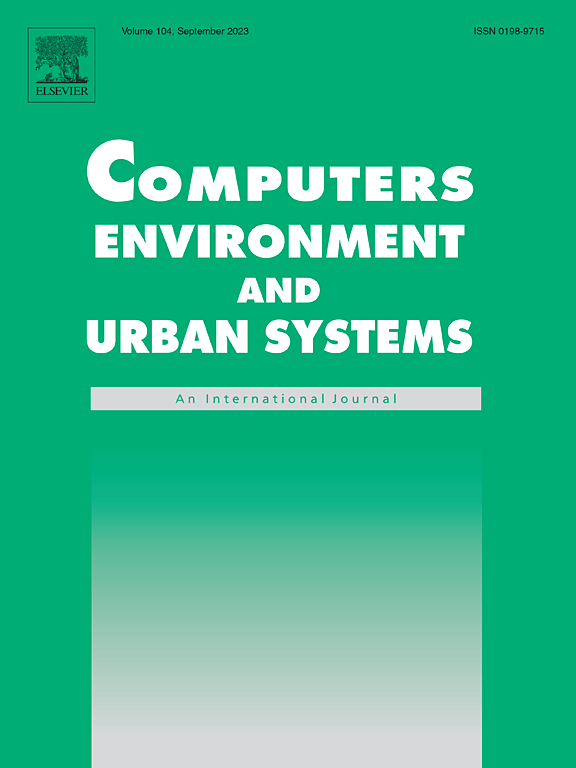将共享电子微流动性建模为用于检测重叠社区的标签传播过程
IF 8.3
1区 地球科学
Q1 ENVIRONMENTAL STUDIES
Computers Environment and Urban Systems
Pub Date : 2025-09-10
DOI:10.1016/j.compenvurbsys.2025.102336
引用次数: 0
摘要
共享的微型交通工具,如电动滑板车(e-scooters),在许多城市都很受欢迎。虽然许多研究利用个人层面的出行数据分析了共享微出行的时空模式,但电动滑板车出行网络的空间结构及其社会经济影响仍未得到充分探讨。通过网络科学的视角审视这些移动网络——比如分析它们的社区结构——可以为城市政策和规划提供有价值的见解。例如,在两个社区的重叠位置分配电动滑板车,可以提高电动滑板车配送的运营效率。然而,现有的检测移动网络中社区结构的方法往往忽略了社区之间潜在的重叠。在本研究中,我们将城市空间中的共享微交通概念化为一种信息交换的过程,通过电动滑板车连接各个地点,促进社区关系的互动和传播。因此,相似的位置被分配了相同的标签。基于这一概念,我们通过设计一个考虑地理距离衰减的说话-听者标签传播算法(SLPA),开发了一个地理空间交互传播模型(GIP),并结合异常检测来确保衍生的社区结构反映有意义的空间模式。我们将该模型应用于华盛顿特区的电动滑板车系统中的重叠社区检测。结果表明,我们的算法在效率和模块化方面都优于现有的重叠社区检测模型。此外,我们发现在重叠的社区中存在显著的社会隔离:属于多个社区的地区往往更富裕,通勤时间更短。我们的研究结果为人类移动网络中的社区结构提供了一个潜在的解释,并可能为城市规划和政策制定提供见解,旨在创造一个更公平和可访问的移动系统。本文章由计算机程序翻译,如有差异,请以英文原文为准。
Modeling shared e-micromobility as a label propagation process for detecting overlapping communities
Shared micro-mobility such as electric scooters (e-scooters) has gained significant popularity in many cities. While many studies have analyzed the spatiotemporal patterns of shared micro-mobility using individual-level trip data, the spatial structure of e-scooter mobility networks and their socio-economic implications remain underexplored. Examining these mobility networks through the lens of network science — such as analyzing their community structures — can provide valuable insights for urban policy and planning. For example, allocating e-scooters at the overlapping locations of two communities may improve the operational efficiency of e-scooter distribution. However, existing methods for detecting community structures in mobility networks often overlook potential overlaps between communities. In this study, we conceptualize shared micro-mobility in urban spaces as a process of information exchange, where locations are connected through e-scooters, facilitating the interaction and propagation of community affiliations. As a result, similar locations are assigned the same label. Based on this concept, we developed a Geospatial Interaction Propagation model (GIP) by designing a Speaker-Listener Label Propagation Algorithm (SLPA) that accounts for geographic distance decay, incorporating anomaly detection to ensure the derived community structures reflect meaningful spatial patterns.We applied this model to detect overlapping communities within the e-scooter system in Washington, D.C. The results demonstrate that our algorithm outperforms existing model of overlapping community detection in both efficiency and modularity. Additionally, we discovered significant social segregation within the overlapping communities: areas belong to multiple communities tend to be wealthier with shorter commute times. Our results provide a potential explanation for the community structure in human mobility networks and may offer insights for urban planning and policymaking aimed at creating a more equitable and accessible mobility system.
求助全文
通过发布文献求助,成功后即可免费获取论文全文。
去求助
来源期刊

Computers Environment and Urban Systems
Multiple-
CiteScore
13.30
自引率
7.40%
发文量
111
审稿时长
32 days
期刊介绍:
Computers, Environment and Urban Systemsis an interdisciplinary journal publishing cutting-edge and innovative computer-based research on environmental and urban systems, that privileges the geospatial perspective. The journal welcomes original high quality scholarship of a theoretical, applied or technological nature, and provides a stimulating presentation of perspectives, research developments, overviews of important new technologies and uses of major computational, information-based, and visualization innovations. Applied and theoretical contributions demonstrate the scope of computer-based analysis fostering a better understanding of environmental and urban systems, their spatial scope and their dynamics.
 求助内容:
求助内容: 应助结果提醒方式:
应助结果提醒方式:


